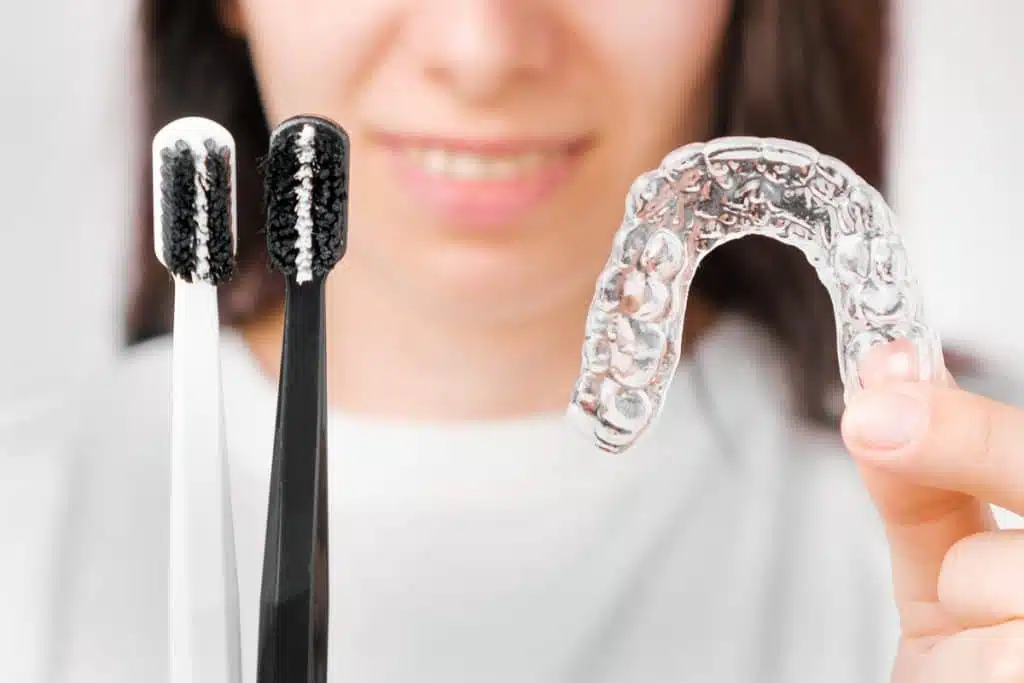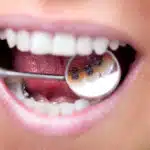You are afraid of braces? You are not alone in this. Here you can learn how the dream of beautiful teeth can still be fulfilled.
You are not alone in your fear of braces. In fact, many people are put off by the thought of wearing braces.
But don’t worry: There are several ways you can deal with this fear and still get your dental correction successfully behind you.
In this article, we will help you understand your concerns and show you ways to overcome your fear of braces.
| Get 150 € discount on your dental correction! |

Book a consultation appointment now at a nearby DrSmile partner practice and find out if teeth straightening with aligners is right for you.
The appointment is completely non-binding and does not involve any costs.
With the code “THATSMILE150” you will receive 150 € discount on the treatment.
Braces are essential for the correction of teeth
In this day and age, it is quite normal to wear braces to correct misaligned teeth.
However, the thought of wearing braces scares many people. This aversion can have various causes.
However, it is important that you understand that only braces are an effective and long-term solution to your misaligned teeth.

Where does the fear of braces come from?
There are several reasons why people are afraid of braces. A common reason is fear of pain or discomfort during treatment.
But some people also worry about their appearance and how those around them might react.
However, most concerns are unfounded. Because wearing braces is often much less uncomfortable than you might imagine.
In addition, there are now numerous options for discreet tooth correction.
The advantages of braces
Before we get into the fears that can come with braces, let’s consider the benefits of braces.
Braces can help correct misaligned teeth, regulate jaw growth and ensure a beautiful smile for the long term.
It can also prevent health problems such as temporomandibular joint pain, gingivitis or tooth decay.

There are several types of braces
There are different types of braces that can be customized to fit your needs. Here are some common variations:
1. metal clamps
Metal braces are the most common type of braces. They consist of metal brackets that are bonded to the teeth and a wire that connects the brackets together.
2. ceramic braces
Ceramic braces are more inconspicuous than metal braces because they are made of transparent material.
They are especially popular with adults who wish to have their teeth straightened discreetly.
3. invisible braces
Invisible braces (aligners) are wafer-thin dental splints that are made to fit precisely and slipped over the teeth.
They offer the most discreet option for straightening teeth. They are removed for eating and for daily oral hygiene. A recommended provider is DrSmile, for example.
The treatment with braces
Treatment with braces requires patience and (for some variants) regular visits to the orthodontist.
The braces exert continuous pressure on the teeth to bring them into the desired position.
It is important to follow the orthodontist’s instructions carefully and to attend regular check-up appointments (if necessary) to have progress checked.
| Get 150 € discount on your dental correction! |

Book a consultation appointment now at a nearby DrSmile partner practice and find out if teeth straightening with aligners is right for you.
The appointment is completely non-binding and does not involve any costs.
With the code “THATSMILE150” you will receive 150 € discount on the treatment.
Fear of braces: ways to cope with it
There are several ways you can manage your fear of braces. Here are some tips:
1. look for a sensitive orthodontist
An empathetic orthodontist can help ease your fears by explaining the treatment steps and addressing your concerns.
2. talk to others who also wear braces
Talking to other people who already wear or have worn braces can help you better prepare for treatment and reduce your fears.
3. informs you about the treatment
Knowing what to expect during treatment can help reduce your anxiety. Learn about the process and the different types of braces.
Tips for successful treatment
To ensure successful treatment with braces, you should follow these tips:
- Get into the habit of good oral hygiene and brush your teeth regularly.
- Avoid hard or sticky foods that could damage braces.
- Wear your aligners or elastics exactly as instructed by the orthodontist .

Disadvantages of teeth straightening with braces
Although braces offer many advantages, there are also some disadvantages that you should consider.
This includes temporary discomfort such as pressure sensitivity or slight pain after the braces have been fitted.
Our tip: Aligners as a discreet and painless alternative to fixed braces
If you are primarily uncomfortable with the thought of unsightly wires and brackets in your mouth, we can recommend aligners as a discreet alternative to fixed braces.
These are wafer-thin, invisible dental splints that are made to fit precisely and slipped over the teeth.
Aligners are invisible to outsiders – the treatment is also painless and often lasts only a few months. In addition, the invisible braces are often available at a lower price than fixed braces.
A key advantage of aligners is also that they are removed for eating and for daily oral hygiene.
In this way, it is much easier to keep teeth and gums clean and healthy during the course of the tooth correction.
Treatment with aligners is suitable for mild to moderate malocclusions.
You can find out whether invisible braces are an option in your case during a free, no-obligation consultation appointment, which you can book here.
Conclusion on the subject of fear of braces
Fear of braces is not uncommon. However, it should not keep you from getting necessary treatment.
In the long run, braces can not only provide serious benefits for your dental health but also have a positive impact on your self-confidence and overall happiness.
With the right information, an empathetic orthodontist, and anxiety management techniques, you can overcome your fears and successfully get through your treatment.
| Get 150 € discount on your dental correction! |

Book a consultation appointment now at a nearby DrSmile partner practice and find out if teeth straightening with aligners is right for you.
The appointment is completely non-binding and does not involve any costs.
With the code “THATSMILE150” you will receive 150 € discount on the treatment.
FAQs on the subject of fear of braces
At this point we will answer some frequently asked questions about the topic of “fear of braces”.
How long does braces treatment take?
The duration of treatment depends on the severity of the malocclusion. As a rule, however, treatment lasts between 12 and 24 months. Treatment is often faster with aligners.
Can I eat with fixed braces?
Yes, you can eat with fixed braces. However, you should avoid hard or sticky foods so as not to damage the braces.
Can I wear braces as an adult?
Yes, many adults choose to wear braces to correct misaligned teeth and improve their smile.
How often do I need to go to the orthodontist?
As part of straightening your teeth with fixed braces, you will need to keep regular appointments with your orthodontist to check the progress of your treatment and make any adjustments. The dates are arranged individually.



Leave a Reply